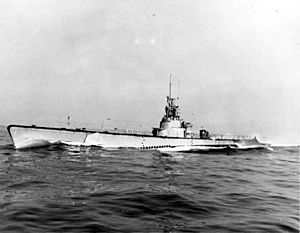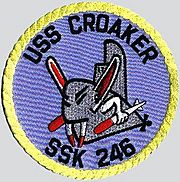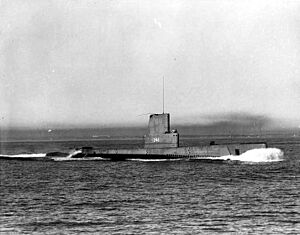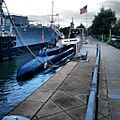USS Croaker facts for kids

Croaker (SS-246), underway, c. 1944–45.
|
|
Quick facts for kids History |
|
|---|---|
| Name | Croaker |
| Namesake | Croaker, Fish |
| Builder | General Dynamics Electric Boat, Groton, Connecticut |
| Laid down | 1 April 1943 |
| Launched | 19 December 1943 |
| Commissioned | 21 April 1944 |
| Decommissioned | 15 June 1946 |
| Recommissioned | 7 May 1951 |
| Decommissioned | 18 March 1953 |
| Recommissioned | 11 December 1953 |
| Decommissioned | 2 April 1968 |
| Stricken | 20 December 1971 |
| Status | Museum ship at Groton, Connecticut on 27 June 1976, then to Buffalo, New York since 1988. |
| Badge |  |
| General characteristics | |
| Class and type | Gato-class diesel-electric submarine |
| Displacement | 1,525 tons (1,549 t) surfaced, 2,424 tons (2,460 t) submerged |
| Length | 311 ft 9 in (95.02 m) |
| Beam | 27 ft 3 in (8.31 m) |
| Draft | 17 ft (5.2 m) maximum |
| Propulsion |
|
| Speed | 21 kn (39 km/h) surfaced, 9 kn (17 km/h) submerged |
| Range | 11,000 nmi (20,000 km) surfaced @ 10 kn (19 km/h) |
| Endurance | 48 hours @ 2 kn (3.7 km/h) submerged, 75 days on patrol |
| Test depth | 300 ft (91 m) |
| Complement | 6 officers, 54 enlisted |
| Armament |
|
|
USS Croaker
|
|
| Location | Buffalo and Erie County Naval & Military Park, Buffalo, New York |
| NRHP reference No. | 08000863 |
| Added to NRHP | 12 September 2008 |
The USS Croaker (SS-246) was a special type of submarine called a Gato-class submarine. It was the first ship in the United States Navy named after the croaker fish. These fish are known for making drumming or throbbing sounds!
The Croaker played an important role during World War II. After the war, it continued to serve the Navy in different ways. Today, you can visit the Croaker as a museum ship in Buffalo, New York.
Contents
Building the Croaker
Building the Croaker began on April 1, 1943. It was constructed by the Electric Boat Company in Groton, Connecticut. The submarine was launched into the water on December 19, 1943. Mrs. W. H. P. Blandy, an admiral's wife, officially named the ship. The Croaker was ready for service on April 21, 1944, with Commander John E. Lee as its first captain.
Croaker in Action
World War II Missions
The Croaker arrived at Pearl Harbor on June 26, 1944. On July 19, it began its first war patrol in the East China Sea and Yellow Sea. This mission was very successful, earning the submarine a special award called the Navy Unit Commendation.
During this patrol, the Croaker sank the Japanese cruiser Nagara on August 7. It also sank an auxiliary minesweeper, Taito Maru, and two cargo ships, Daigen Maru No. 7 and Yamateru Maru. The submarine also helped rescue pilots during air attacks on the Bonin Islands.
After getting supplies at Midway Atoll, the Croaker went on its second patrol. It worked with other submarines to attack enemy ships. It sank two more cargo ships, Shinki Maru and Hakuran Maru. It also sank the cargo ship Mikage Maru and damaged another, Gassan Maru. With no torpedoes left, it returned to Pearl Harbor.
The third patrol for the Croaker was from December 1944 to February 1945. It patrolled the Luzon Strait and South China Sea. During this time, it didn't find enemy ships to attack. However, it provided important lifeguard services for pilots. These pilots were flying missions over Luzon before a major invasion.
The Croaker had two more patrols. Its fifth patrol was in the Java Sea. Its final war patrol, from July 1 to August 13, involved lifeguard duties. It helped pilots in the South China Sea and near Hong Kong during the last air attacks on Japan.
After its wartime service, the Croaker sailed back to the United States. It was taken out of service on May 15, 1946, and placed in reserve.
After the War
The Croaker was brought back into service on May 7, 1951. It became a training ship near New London, Connecticut. On March 18, 1953, it was taken out of service again. This time, it was changed into a special type of submarine called a hunter-killer submarine. These submarines were designed to hunt other submarines.
It was recommissioned on December 11, 1953, and given a new classification: SSK-246. Starting in February 1954, it operated along the East Coast of the U.S. and in the Caribbean Sea. It also visited ports in England for NATO exercises in 1957 and 1958.
In August 1959, the Croaker was reclassified as SS-246. It went on special exercises to England again in February 1960. Later that year, in September, the Croaker took a long trip. It sailed through the Mediterranean Sea and the Suez Canal. It visited ports in the Near East and Karachi, Pakistan, before returning home in December.
In May 1967, the Croaker was reclassified as an Auxiliary Submarine, AGSS-246. It was taken out of service for the last time on April 2, 1968. The Navy officially removed it from its list of active ships on December 20, 1971. It was then reclassified as IXSS-246.
From 1977 to 1987, the Croaker was a private attraction in Groton, Connecticut. Since 1988, the Croaker has been a museum ship. You can visit it at the Buffalo and Erie County Naval & Military Park in Buffalo, New York.
Awards and Recognition
The USS Croaker received several awards for its service:
- Navy Unit Commendation
- American Campaign Medal
- Asiatic-Pacific Campaign Medal with three battle stars
- World War II Victory Medal
- National Defense Service Medal with star
The Croaker earned three battle stars for its successful war patrols during World War II. It is recognized for sinking 19,710 tons of enemy ships. The Croaker was also added to the National Register of Historic Places on September 12, 2008.
Images for kids
See also
- Gato-class submarine#Hunter-killer - Learn more about hunter-killer submarines.
- Attack submarine - Discover what an attack submarine does.










